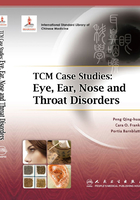
上QQ阅读APP看书,第一时间看更新
Chapter 8 Vernal Keratoconjunctivitis
Vernal keratoconjunctivitis (VKC), also called seasonal conjunctivitis or spring catarrh, is a recurrent seasonal allergic conjunctivitis. The main clinical symptoms of VKC are intense itching in the eyes, large “cobblestone” papillae on the palpebral conjunctiva, and brown or dull red jelly-like thickening of the bulbar conjunctiva. The symptoms usually occur bilaterally. This disease is seasonal, typically occurring during the spring and summer months, with the symptoms diminishing or disappearing during autumn and winter. Generally, the onset of VKC occurs during preadolescence. It is more common among men than women, and those with other infammatory allergic disorders are at higher risk to have the condition.
In TCM, this condition is associated with a variety of Chinese medical paterns. The most common paterns are a combination of insecurity of lung- wei defensive qi, along with wind-heat attacking the eyes. The surface vacuity allows wind heat to invade and lodge in the striae and interstitial spaces of the eyelid and the canthus.
Other paterns include: damp-heat accumulation in the spleen-stomach coupled with pathogenic wind invasion. In these cases damp and heat are conducted with the clear yang from the spleen stomach and expressed in the eyes, causing a vulnerability to external invasion by wind, which leads to accumulation and stagnation of pathogens in the eyelids and bulbar conjunctiva. Additionally, internal wind can occur due to defciency of liver blood, which may be exacerbated by seasonal changes in the constitution, or weather.
This diseased is predominantly related to the disorders of the lungs, spleen, and stomach. The patterns reflect a state of deficiency, excess, or mixed deficiency and excess.